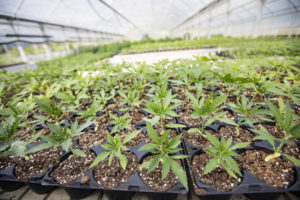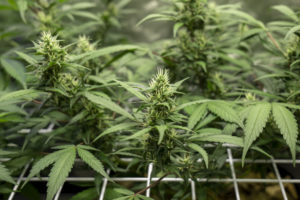There are a couple of reasons to grow hemp indoors over the winter months on a small scale. Some hemp farmers use the cold season to test grow several different strains of hemp to evaluate them ahead of a large-scale seed purchase. There are also those who enjoy growing hemp for personal use, harvesting small quantities of flower. Both these types of indoor grower are the reason that we started selling starter packs and variety packs – these small-quantity packs (20 seeds each) make it easy to explore several varieties as you search for your personal favorites. Whatever your motivation, we know you want these indoor grows to be productive, so today, I wanted to review some of the basics that will help you succeed.
STEP ONE: KNOW YOUR SEEDS!

Hemp plants are male or female. You can buy seed that is 50/50 or you can buy feminized seed, which will produce only female plants. If you want hemp flower, you will be better off buying the more productive feminized seed. If you want fiber, it makes no difference if you grow male or female plants. What you DON’T want is a plant that produces male and female flowers – called a hermaphrodite — which will reduce flower quality. Hermaphroditism can happen if the plants are stressed from environmental factors.
I strongly recommend that you purchase your seed from a reputable, experienced commercial seed seller, properly licensed in their state or province, who offers some type of product guarantee. You will also want to look at the sellers’ CBD/THC ratio data to confirm that it fits your specific production goals.
STEP TWO: GETTING YOUR SEEDS STARTED

OK! We’ve got our seeds and now we need to wake them up! They need moisture. My favorite technique is to lay seeds out on soaking wet paper towels and let them sit for about 24 hours with a temperature between 65-70 degrees. Keep an eye on them and don’t let the towels dry out. Keeping a spray bottle or a small water bottle handy is a good idea.
Plant your pre-soaked seeds in a moist growing medium, nestling them about one half inch deep. If you choose soil, make sure that it is sterilized, peat-free potting compost. Optimal soil-less options contain high quantities of coco coir and perlite. We prefer the soil-less method in our operation as it reduces risks from pests and overwatering. If you go the soil-less route, just keep in mind that your plants will draw ALL their nutrients from water. Growing hemp hydroponically is a third option, but for today’s conversation, we’ll stick with the two most common medium above.
There are a lot of seed-starter trays commercially available online, at garden centers, or indoor growing specialty outlets. Some are reusable plastic while some are biodegradable so you can repot easily as seedlings mature. You may also want to purchase a heat mat – a relatively inexpensive investment that helps maintain a constant, warm soil temperature if your grow room gets cold at night.
STEP THREE: VEGETATIVE PHASE

Cannabis Seedlings Growing in Greenhouse on a Farm.
The vegetative phase – approximately 30-60 days – starts when the hemp seed germinates and starts to establish roots. During this phase, maintain the temperature between 68 and 77 degrees, and get set up to deliver 18-24 hours of light per day from high-output HPS or LEDs or T5 fluorescent grow lights. If the seedlings get “leggy”, lower the lamp closer to the plants. Get nutrients and water to your seedlings appropriate to the type of growing medium you are using. Emerald Growers published a terrific review earlier this year that provides a detailed breakdown of several nutrient products and their benefits. Note that nutrient needs of your plants will change from phase to phase.
The vegetative stage can be sustained indefinitely. Check your grow every day and watch for any signs that indicate insufficient light, water, or nutrition. During the vegetative phase, aim for temperatures in the 70-82 degree range and a humidity level between 40-70 percent. Don’t let those roots sit in soggy soil! The main cause of problems and mortality at this stage is overwatering – let the medium get somewhat dry before you water again. Remember, it is practically impossible to overwater your plants if they are planted in rockwool.
STEP FOUR: FLOWERING PHASE

A large number of cannabis flowers of employee concepts of profuse cultivation, Commercial hemp farming in a greenhouse. Industrial hemp is grown to produce CBD oil and other hemp-derived products.
Now the fun begins! Indoor growers induce the flowering phase by reducing the light period to 12 hours a day. That 12 hours of dark is critical to getting your plants out of the vegetative phase. (Even a momentary flash of light will destroy the ‘budding hormones’ and the plant will have to reset, so don’t let any light on the plants when they are in their dark period, even for a second.) The females will immediately start the flowering cycle because of the abrupt change in photoperiod and you should start to see flowers after week two. The plant will still grow wider and taller for two or three weeks, so make sure you start flowering early enought in the vegetative state, this takes some experience with each strain. By the start of week six in flower, the buds will be large, sticky, and still maturing. Most hemp strains grown indoors will be approaching the 0.3 percent THC limit at this point. Plants in flowering phase will thrive in slightly cooler temperatures (68-77 degrees) and a little less humidity – about 40-50 percent. As plants mature, consider adding a fan to your layout to circulate air and discourage pests and disease.
A FINAL WORD
Note that you can use your indoor hemp grow as a laboratory to experiment with the tolerances different strains have regarding environmental factors such as water, light, nutrients, and disease/pest resistance. If you go this route, I urge you to notate and label everything so you come away with useful, insightful data that you can use to improve your performance and production.
Pay attention to all these details and before you know it, you’ll be enjoying the yield from your indoor winter grow!
Think green, friends! Happy growing!


Recent Comments